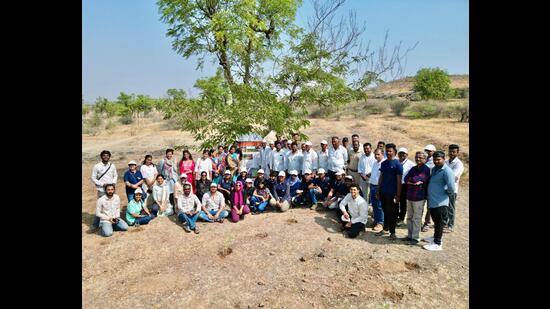Pilot project to study carbon sequestration in grassland areas
UNESCO defines Savannah grassland as land covered with herbaceous plants 10-40% of tree and shrub cover
The District Collector’s office, with the help of two NGO partners from Pune and Bengaluru, has initiated a pilot project in five villages to study carbon sequestration in grassland areas. The study will be conducted in five villages; However, the initial study has started at Gulanche village in Purandar at around 20 hectares of land, said the official.

UNESCO defines Savannah grassland as land covered with herbaceous plants 10-40% of tree and shrub cover. These grasslands contribute to livestock feeding. The grasslands are also the habitat for many herbivores. The ecosystem is also essential for carbon sinks as they sequester a significant amount of carbon below ground. Various research revealed that grasslands are also unique as the carbon below ground remains stable even after disturbances like fire or herbivory.
The grasses are adapted to sequester carbon in a more water-efficient manner.
Pune, which among one of the cities that record higher carbon emissions throughout the year, needs immediate intervention to reduce carbon emissions. To achieve this goal, grasslands may become a useful source. However, it is necessary to collect proper data before the policy decision and implementation. Considering this, the district collector’s office came up with a pilot project on grassland restoration to study the impact of carbon sequestration.
Accordingly, the work has already started at Gulanche village in Purandar tehsil by The Grassland Trust, Pune, and Ashoka Trust for Research in Ecology and the Environment (ATREE), Bengaluru.
Poonam Mehta, deputy commissioner, the district collectorate said, “The Pune division has initiated a pilot project aimed at creating grasslands to address issues such as land degradation and fodder insufficiency. This initiative also provides a solution for carbon sequestration, as grasslands play a crucial role in reducing carbon emissions. To promote awareness about carbon reduction, the division has established a Carbon Neutrality Facilitation Cell. These restoration projects should be expanded to an extensive level to raise awareness among the masses.”
Earlier, grassland restoration work was initiated in forest areas. Recently an MoU was signed between the Forest Department and The Grassland Trust for the grassland restoration in forest areas in the Pune district. Now a similar project is also being implemented outside the forest area.
Mihir Godbole, founder of The Grasslands Trust, said, “We shall carry out scientifically responsible savannah grassland restoration projects in the Pune district. These will benefit the biodiversity, generate fodder for the residents of the landscape, and facilitate the carbon sequestration to counter climate change.”






